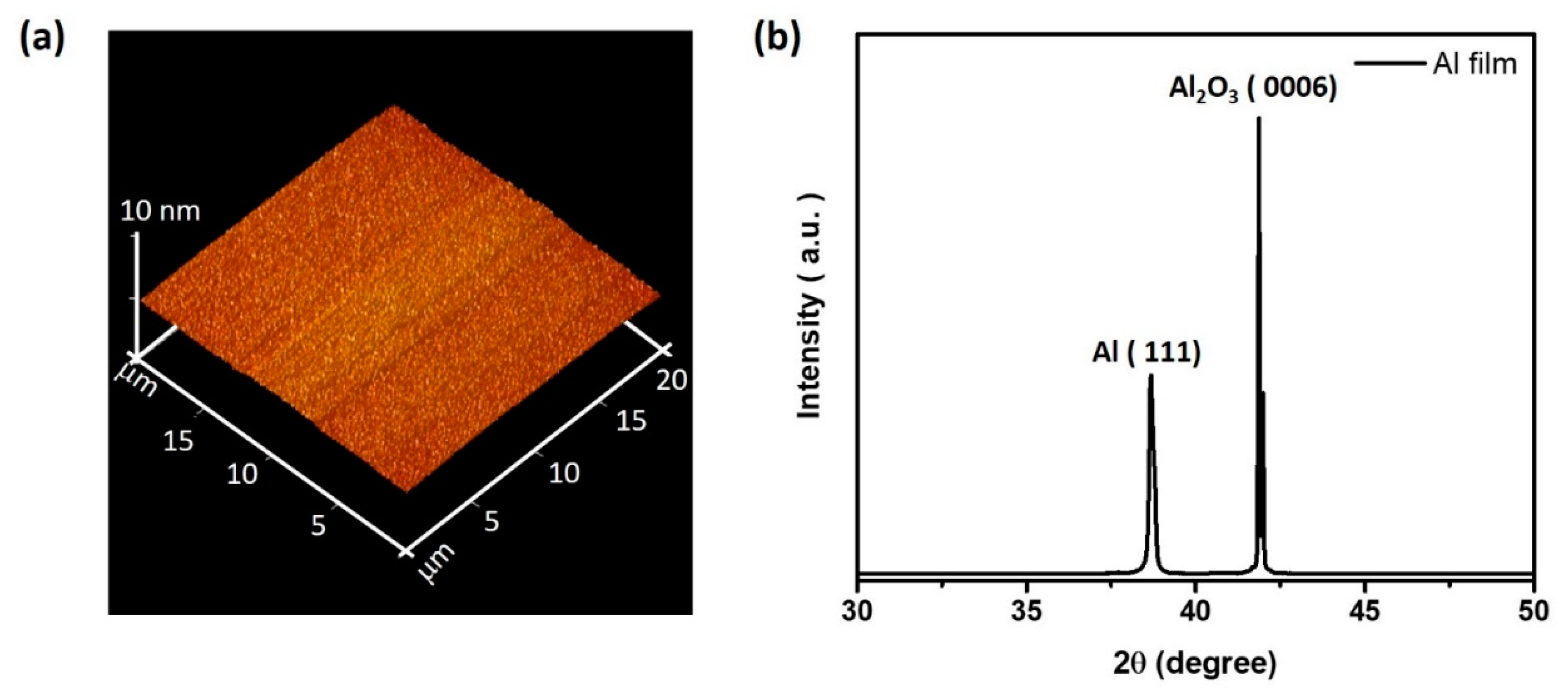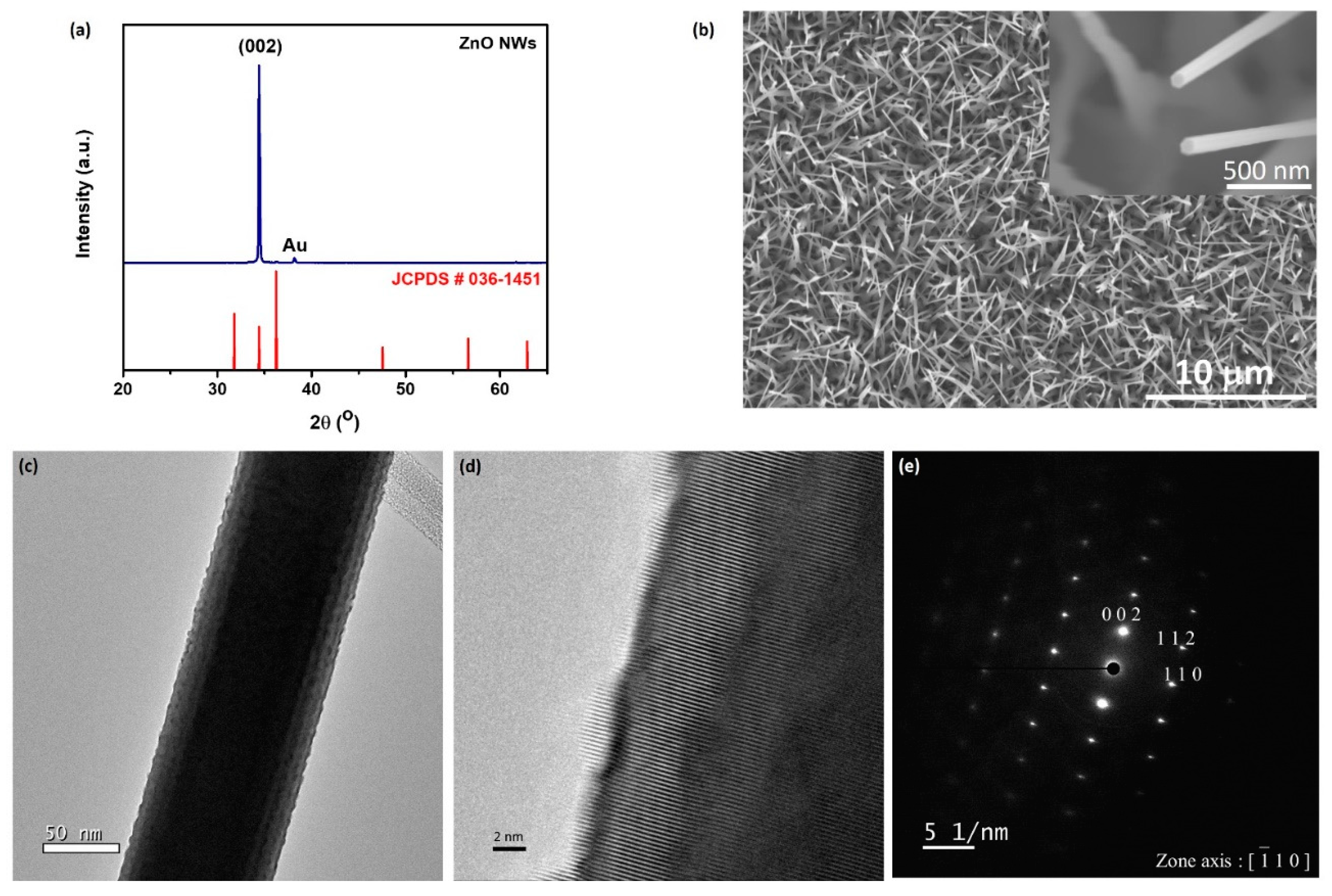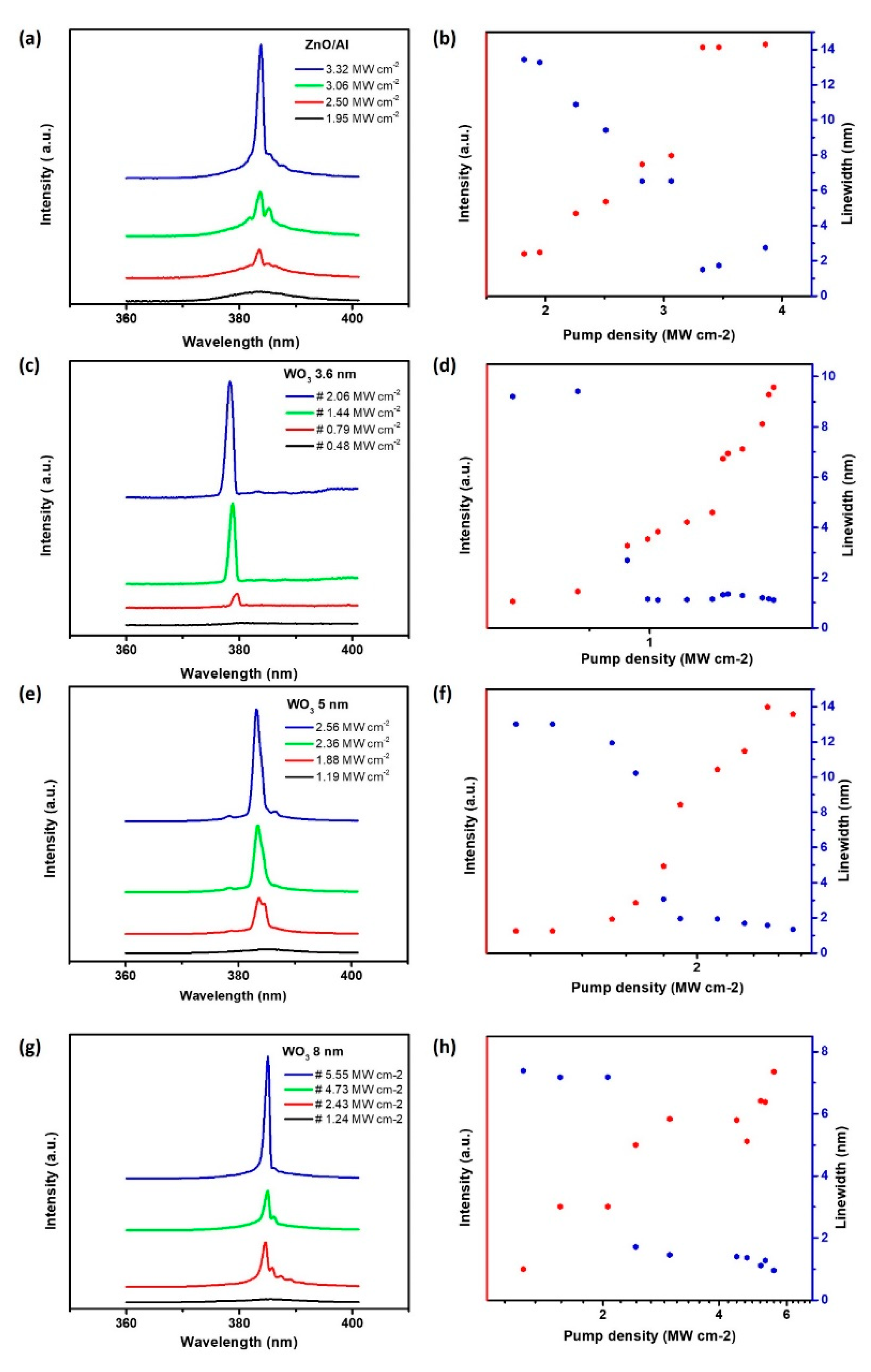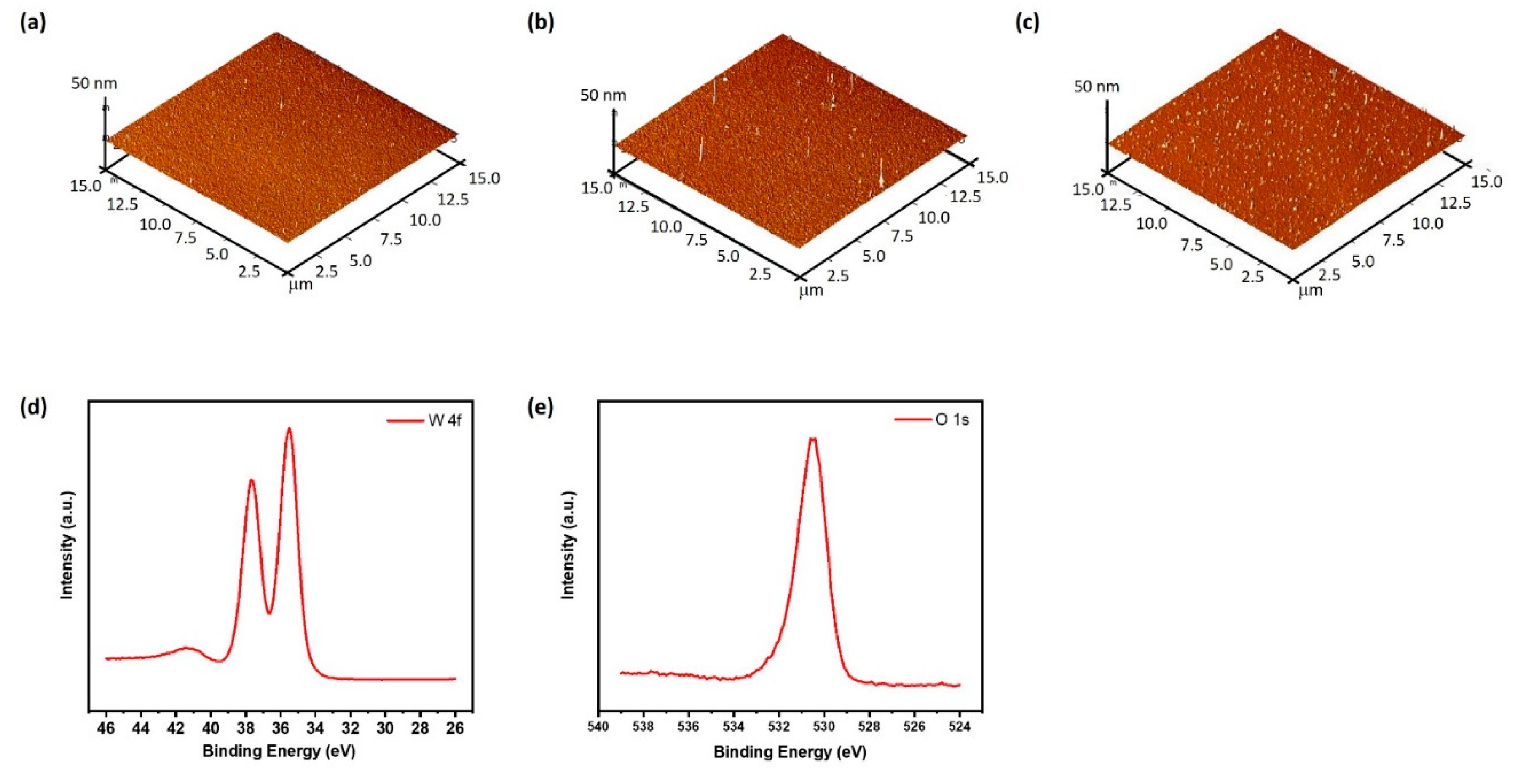ZnO Nanowires on Single-Crystalline Aluminum Film Coupled with an Insulating WO3 Interlayer Manifesting Low Threshold SPP Laser Operation
Abstract
1. Introduction
2. Experiment
2.1. Synthesis of ZnO Nanowires
2.2. Growth of Epitaxial Aluminum Film
2.3. Measurement System
2.4. Plasmonic Device Fabrication
3. Results and Discussion
4. Conclusions
Supplementary Materials
Author Contributions
Funding
Conflicts of Interest
References
- Khlebtsov, N.G.; Dykman, L.A. Optical Properties and Biomedical Applications of Plasmonic Nanoparticles. J. Quant. Spectrosc. Ra. 2010, 111, 1–35. [Google Scholar] [CrossRef]
- Huang, C.; Ye, J.; Wang, S.; Stakenborg, T.; Lagae, L. Gold Nanoring as a Sensitive Plasmonic Biosensor for on-chip DNA Detection. Appl. Phys. Lett. 2012, 100, 173114. [Google Scholar]
- Chen, C.; Juan, M.L.; Li, Y.; Maes, G.; Borghs, G.; Van Dorpe, P.; Quidant, R. Enhanced Optical Trapping and Arrangement of Nano-Objects in a Plasmonic Nanocavity. Nano Lett. 2012, 12, 125–132. [Google Scholar] [CrossRef]
- Roxworthy, B.J.; Ko, K.D.; Kumar, A.; Fung, K.H.; Chow, E.K.C.; Liu, G.L.; Fang, N.X.; Toussaint, K.C. Application of Plasmonic Bowtie Nanoantenna Arrays for Optical Trapping, Stacking, and Sorting. Nano Lett. 2012, 12, 796–801. [Google Scholar] [CrossRef] [PubMed]
- Hill, M.T.; Marell, M.; Leong, E.S.P.; Smalbrugge, B.; Zhu, Y.C.; Sun, M.H.; Van Veldhoven, P.J.; Geluk, E.J.; Karouta, F.; Oei, Y.S.; et al. Lasing in Metal-insulator-metal Sub-wavelength Plasmonic Waveguides. Opt. Express 2009, 17, 11107–11112. [Google Scholar] [CrossRef] [PubMed]
- Nezhad, M.P.; Simic, A.; Bondarenko, O.; Slutsky, B.; Mizrahi, A.; Feng, L.A.; Lomakin, V.; Fainman, Y. Room-temperature Subwavelength Metallo-dielectric Lasers. Nat. Photonics 2010, 4, 395–399. [Google Scholar] [CrossRef]
- Atwater, H.A.; Polman, A. Plasmonics for Improved Photovoltaic Devices. Nat. Mater. 2010, 9, 205–213. [Google Scholar] [CrossRef]
- Liu, W.L.; Lin, F.C.; Yang, Y.C.; Huang, C.H.; Gwo, S.; Huang, M.H.; Huang, J.S. The Influence of Shell Thickness of Au@TiO2 Core-shell Nanoparticles on the Plasmonic Enhancement Effect in Dye-sensitized Solar Cells. Nanoscale 2013, 5, 7953–7962. [Google Scholar] [CrossRef]
- Schuller, J.A.; Barnard, E.S.; Cai, W.S.; Jun, Y.C.; White, J.S.; Brongersma, M.L. Plasmonics for Extreme Light Concentration and Manipulation. Nat. Mater. 2010, 9, 193–204. [Google Scholar] [CrossRef]
- Ho, Y.L.; Clark, J.K.; Syazwan, A.; Kamal, A.; Delaunay, J.J. On-Chip Monolithically Fabricated Plasmonic-Waveguide Nanolaser. Nano Lett. 2018, 18, 7769–7776. [Google Scholar] [CrossRef]
- Binggeli, M.; Li, F. Scaling Optical Communication for On-Chip Interconnect. In Proceedings of the 19th International Conference on Electronic Packaging Technology (Icept), Shanghai, China, 8–11 August 2018; pp. 1178–1183. [Google Scholar]
- Altug, H.; Englund, D.; Vuckovic, J. Ultrafast Photonic Crystal Nanocavity Laser. Nat. Phys. 2006, 2, 484–488. [Google Scholar] [CrossRef]
- Ding, K.; Ning, C.Z. Metallic Subwavelength-cavity Semiconductor Nanolasers. Light Sci. Appl. 2012, 1, e20. [Google Scholar] [CrossRef]
- Wan, Y.H.; Zheng, Z.; Shi, X.G.; Bian, Y.S.; Liu, J.S. Hybrid Plasmon Waveguide Leveraging Bloch Surface Polaritons for Sub-wavelength Confinement. Sci. China Technol. Sci. 2013, 56, 567–572. [Google Scholar] [CrossRef]
- Zhang, B.; Bian, Y.S.; Ren, L.Q.; Guo, F.; Tang, S.Y.; Mao, Z.M.; Liu, X.M.; Sun, J.J.; Gong, J.Y.; Guo, X.S.; et al. Hybrid Dielectric-loaded Nanoridge Plasmonic Waveguide for Low-Loss Light Transmission at the Subwavelength Scale. Sci. Rep. 2017, 7, 1–9. [Google Scholar] [CrossRef]
- Barnes, W.L.; Dereux, A.; Ebbesen, T.W. Surface plasmon subwavelength optics. Nature 2003, 424, 824–830. [Google Scholar] [CrossRef]
- Chou, Y.H.; Chou, B.T.; Lai, Y.Y.; Yang, C.T.; Chiang, C.K.; Lin, S.D.; Lin, T.R.; Lin, C.C.; Kuo, H.C.; Wang, S.C.; et al. Ultraviolet Lasing in a ZnO Plasmonic Nanolaser. In Proceedings of the 24th IEEE International Semiconductor Laser Conference, Palma de Mallorca, Spain, 7–10 September 2014; pp. 84–85. [Google Scholar]
- Zhang, Q.; Li, G.Y.; Liu, X.F.; Qian, F.; Li, Y.; Sum, T.C.; Lieber, C.M.; Xiong, Q.H. A Room Temperature Low-threshold Ultraviolet Plasmonic Nanolaser. Nat. Commun. 2014, 5, 1–9. [Google Scholar] [CrossRef]
- Lu, Y.J.; Wang, C.Y.; Kim, J.; Chen, H.Y.; Lu, M.Y.; Chen, Y.C.; Chang, W.H.; Chen, L.J.; Stockman, M.I.; Shih, C.K.; et al. All-Color Plasmonic Nanolasers with Ultralow Thresholds: Autotuning Mechanism for Single-Mode Lasing. Nano Lett. 2014, 14, 4381–4388. [Google Scholar] [CrossRef]
- Wu, C.Y.; Kuo, C.T.; Wang, C.Y.; He, C.L.; Lin, M.H.; Ahn, H.; Gwo, S. Plasmonic Green Nanolaser Based on a Metal-Oxide-Semiconductor Structure. Nano Lett. 2011, 11, 4256–4260. [Google Scholar] [CrossRef]
- Bergman, D.J.; Stockman, M.I. Surface Plasmon Amplification by Stimulated Emission of Radiation: Quantum Generation of Coherent Surface Plasmons in Nanosystems. Phys. Rev. Lett. 2003, 90, 027402. [Google Scholar] [CrossRef]
- Noginov, M.A.; Zhu, G.; Belgrave, A.M.; Bakker, R.; Shalaev, V.M.; Narimanov, E.E.; Stout, S.; Herz, E.; Suteewong, T.; Wiesner, U. Demonstration of a Spaser-based Nanolaser. Nature 2009, 460, 1110–1112. [Google Scholar] [CrossRef]
- Chou, Y.H.; Chou, B.T.; Chiang, C.K.; Lai, Y.Y.; Yang, C.T.; Li, H.; Lin, T.R.; Lin, C.C.; Kuo, H.C.; Wang, S.C.; et al. Ultrastrong Mode Confinement in ZnO Surface Plasmon Nanolasers. ACS Nano 2015, 9, 3978–3983. [Google Scholar] [CrossRef] [PubMed]
- Lu, Y.J.; Kim, J.; Chen, H.Y.; Wu, C.H.; Dabidian, N.; Sanders, C.E.; Wang, C.Y.; Lu, M.Y.; Li, B.H.; Qiu, X.G.; et al. Plasmonic Nanolaser Using Epitaxially Grown Silver Film. Science 2012, 337, 450–453. [Google Scholar] [CrossRef] [PubMed]
- Baek, H.; Park, J.B.; Park, J.W.; Hyun, J.K.; Yoon, H.; Oh, H.; Yoon, J. ZnO Nanolasers on Graphene Films. Appl. Phys. Lett. 2016, 108, 263102. [Google Scholar] [CrossRef]
- Vanmaekelbergh, D.; Van Vugt, L.K. ZnO Nanowire Lasers. Nanoscale 2011, 3, 2783–2800. [Google Scholar] [CrossRef] [PubMed]
- Zamfirescu, M.; Kavokin, A.; Gil, B.; Malpuech, G.; Kaliteevski, M. ZnO as a Material Mostly Adapted for the Realization of Room-temperature Polariton Lasers. Phys. Rev. B 2002, 65, 161205. [Google Scholar] [CrossRef]
- Chou, Y.H.; Wu, Y.M.; Hong, K.B.; Chou, B.T.; Shih, J.H.; Chung, Y.C.; Chen, P.Y.; Lin, T.R.; Lin, C.C.; Lin, S.D.; et al. High-Operation-Temperature Plasmonic Nanolasers on Single-Crystalline Aluminum. Nano Lett. 2016, 16, 3179–3186. [Google Scholar] [CrossRef]
- Liao, Y.J.; Cheng, C.W.; Wu, B.H.; Wang, C.Y.; Chen, C.Y.; Gwo, S.; Chen, L.J. Low Threshold Room-Temperature UV Surface Plasmon Polariton Lasers with ZnO Nanowires on Single-crystal Aluminum Films with Al2O3 interlayers. RSC Adv. 2019, 9, 13600–13607. [Google Scholar] [CrossRef]
- Gong, T.; Munday, J.N. Aluminum-based Hot Carrier Plasmonics. Appl. Phys. Lett. 2017, 110, 02117. [Google Scholar] [CrossRef]
- Huang, M.H.; Mao, S.; Feick, H.; Yan, H.Q.; Wu, Y.Y.; Kind, H.; Weber, E.; Russo, R.; Yang, P.D. Room-temperature Ultraviolet Nanowire Nanolasers. Science 2001, 292, 1897–1899. [Google Scholar] [CrossRef]
- Raether, H. Surface-Plasmons on Smooth and Rough Surfaces and on Gratings; Springer Tracts in Modern Physics; Springer: Berlin/Heidelberg, Germany, 1988; Volume 111, pp. 1–133. [Google Scholar]





© 2020 by the authors. Licensee MDPI, Basel, Switzerland. This article is an open access article distributed under the terms and conditions of the Creative Commons Attribution (CC BY) license (http://creativecommons.org/licenses/by/4.0/).
Share and Cite
Agarwal, A.; Tien, W.-Y.; Huang, Y.-S.; Mishra, R.; Cheng, C.-W.; Gwo, S.; Lu, M.-Y.; Chen, L.-J. ZnO Nanowires on Single-Crystalline Aluminum Film Coupled with an Insulating WO3 Interlayer Manifesting Low Threshold SPP Laser Operation. Nanomaterials 2020, 10, 1680. https://doi.org/10.3390/nano10091680
Agarwal A, Tien W-Y, Huang Y-S, Mishra R, Cheng C-W, Gwo S, Lu M-Y, Chen L-J. ZnO Nanowires on Single-Crystalline Aluminum Film Coupled with an Insulating WO3 Interlayer Manifesting Low Threshold SPP Laser Operation. Nanomaterials. 2020; 10(9):1680. https://doi.org/10.3390/nano10091680
Chicago/Turabian StyleAgarwal, Aanchal, Wei-Yang Tien, Yu-Sheng Huang, Ragini Mishra, Chang-Wei Cheng, Shangjr Gwo, Ming-Yen Lu, and Lih-Juann Chen. 2020. "ZnO Nanowires on Single-Crystalline Aluminum Film Coupled with an Insulating WO3 Interlayer Manifesting Low Threshold SPP Laser Operation" Nanomaterials 10, no. 9: 1680. https://doi.org/10.3390/nano10091680
APA StyleAgarwal, A., Tien, W.-Y., Huang, Y.-S., Mishra, R., Cheng, C.-W., Gwo, S., Lu, M.-Y., & Chen, L.-J. (2020). ZnO Nanowires on Single-Crystalline Aluminum Film Coupled with an Insulating WO3 Interlayer Manifesting Low Threshold SPP Laser Operation. Nanomaterials, 10(9), 1680. https://doi.org/10.3390/nano10091680






